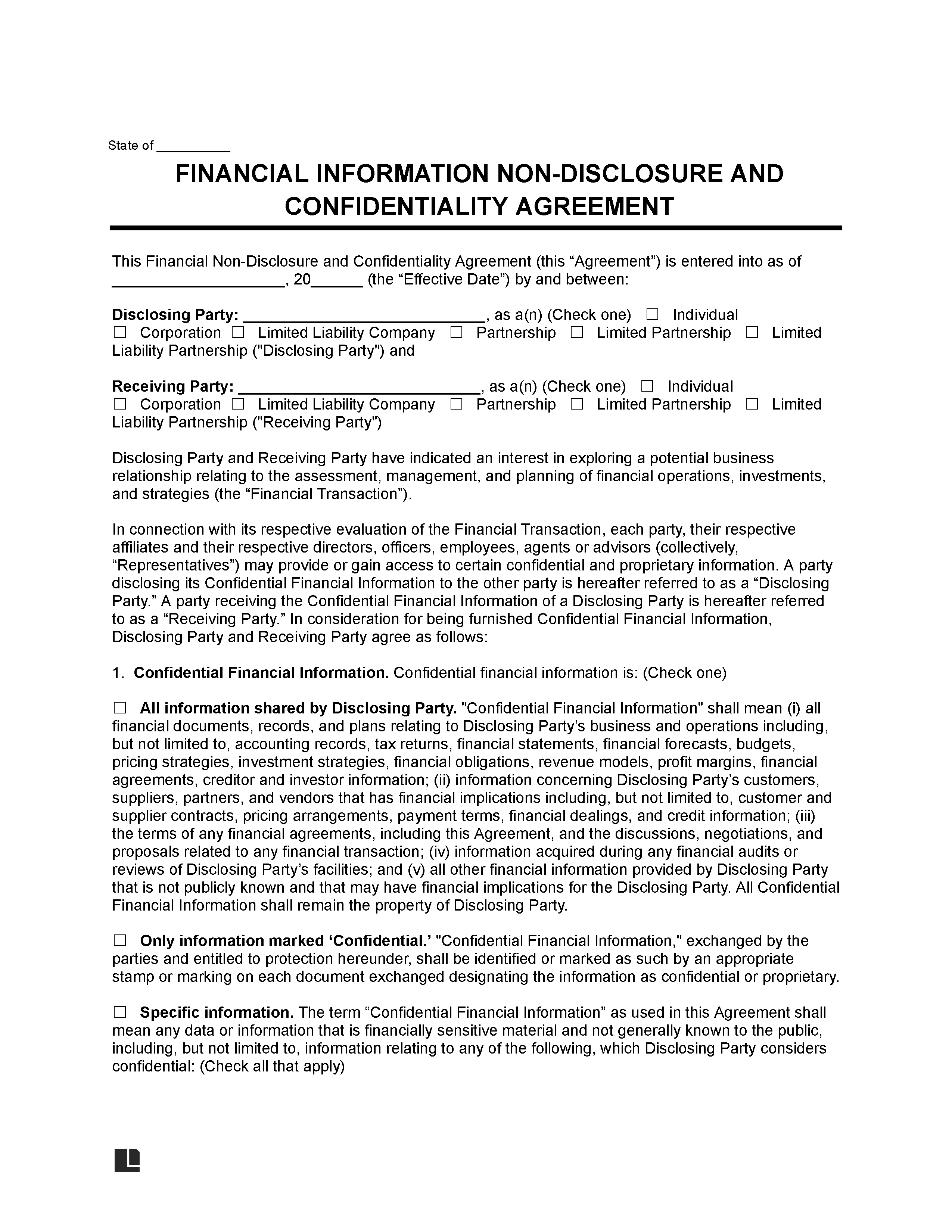A financial information non-disclosure agreement is a legally binding document protecting the disclosure of financial information that could affect a business transaction. It ensures the information remains private, preventing public knowledge of the information from interfering with a transaction’s outcome.
When to Use a Financial Information NDA
- Investor Relations: Protects financial strategies, revenue forecasts, and other sensitive data from being misused or shared with competitors.
- Mergers & Acquisitions: Ensures that confidential financial details shared during merger, acquisition, or business sale negotiations remain private until the deal is completed.
- Partnerships & Collaborations: Safeguards critical financial data when working with other companies on joint ventures.
- Employee Agreements: Requires employees with financial access to maintain confidentiality.
- Vendor Relationships: Prevents vendors or suppliers with access to financial data from disclosing strategies or pricing details.
How to Write a Financial Information Non-Disclosure Agreement
Step 1 – Identify the Parties
Identify the parties involved in the agreement. The “disclosing party” is the entity sharing the financial information, while the “receiving party” is the entity that will have access to the confidential data. Include the parties’ full legal names, addresses, and contact information.
Step 2 – Define the Confidential Financial Information
State the purpose of sharing confidential financial information. It may be to evaluate a potential business transaction, conduct due diligence, or explore partnership opportunities.
Then, define what constitutes confidential financial information. It may include all the information the disclosing party shares or certain types of information, such as financial statements, investment strategies, stock options, employee salaries, budgets, and any other information you wish to protect.
Step 3 – Clarify Exclusions and Obligations
Specify what information is excluded from the definition of confidential information. For example, confidential financial information can’t be information that the receiving party develops independently or information that becomes publicly known (not courtesy of the receiving party’s disclosure).
The agreement should also outline the permitted uses of the information and any restrictions on its disclosure to third parties. Furthermore, it should outline the obligations of the disclosing and receiving parties. These obligations may include:
- Protect the integrity of confidential information
- Adopt and maintain security protocols as necessary
- Return or destroy confidential information at the end of the contract
- Take corrective measures if confidential information is accidentally leaked
Step 4 – State the Contract’s Duration
Specify the duration for which the confidential financial information will be protected. This time frame can vary depending on the nature of the information and the parties’ requirements.
Step 5 – Identify the Remedies Available in Case of a Breach
Specify the remedies available in case of a violation to enforce the NDA and deter potential breaches. These recourse options may include injunctive relief, monetary damages, or other appropriate remedies. The remedies clause should be proportionate to the harm the breach causes.
Step 6 – Specify Governing Law and Jurisdiction
State the law and jurisdiction governing any disputes arising from the agreement. This addition confirms that the parties know the legal framework within which the NDA will be interpreted and enforced.
Step 7 – Sign and Date the Form
Sign and date the NDA and ensure each party receives a copy for their records. Some agreements may require notarization or witness signatures, so check the legal requirements in your jurisdiction.
Financial Information Non-Disclosure Agreement Sample
Below, you can download a financial information non-disclosure agreement template in PDF or Word format.


